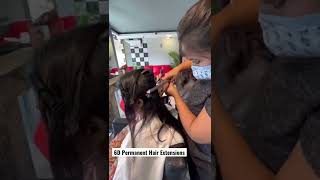DIY Natural Hair Dyeing Using Henna
Henna lovers constitute a separate caste within the beauty industry. They appreciate Mother Nature’s gifts instead of searching for fast synthetic solutions. In fact, henna has been used for centuries by women for hair growth, treatment and coloring. Apart from deep natural shades, it helps to make hair strong, voluminous and healthy, nourishing roots and building protective layers for strands through the whole length. So, what, are you ready for life-changing hair dyeing hacks? Take your seats, because this article is your guided step-by-step journey to DIY henna solutions!
The Bustle of Preparations
To start at-home henna hair dyeing, you need to decide on the desired shade that depends on your starting color and additional ingredients. There are a lot of smart boxed natural henna products with clear palettes (LUSH, khadi and many other brands have made it easier). If you want to buy the cheapest henna, be ready for deep orange-reddish colors (if the starting one is light) or a gentle rouge shade (if your hair is pretty dark). Also, you can mix henna powder to achieve more specific colors. Here’re some ideas:
- Indigo powder helps to get a darker color. It’s also a strong organic dye that sometimes is called The Black Henna. Adjust the proportions depending on your desired tone (from chestnut to blue-black).
- Coffee can also darken the henna, resulting in more of a golden brown shade.
- Lemon juice helps to achieve a deep auburn henna color in a short amount of time. Other acidic liquids also make a henna mixture release its dye faster, but lemons are always at hand.
- Cranberry juice gives a mid-red tone to the final color.
- Fresh lime juice promises to make it darker.
- Strong chamomile tea makes the classic henna color lighter.
- Beet juice adds pink undertones. Use hot beet juice at the final step when mixing henna.
Excluding indigo powder’s famous coloring powers, the impact of these additional ingredients is quite subtle, but it can really help to get the tone you’re looking for. Get creative without damaging your hair!

Instagram / @liamarieart
Mixing Henna and Waiting Time
When you’ve already bought pure henna and chosen extra ingredients, let’s move to the next step and start cooking a magic mixture:
- Take a glass or wooden bowl where you can place henna powder and a sufficient amount of hot water plus additional ingredients. The amount of henna needed for one dye depends on your hair length and thickness. Experienced henna users advise to prepare more mixture to avoid shortage of the product at the crucial moment.
- Using a spoon or whisk, gently mix henna to the consistency of thick yogurt. Add water gradually to avoid lumps and disproportion.
- Cover the bowl with the help of plastic wrap or foil and rest it overnight at room temperature. This time is needed for releasing the dye. You can easily shorten this period by placing the bowl in any warm place for a couple of hours.
- After the needed amount of time has passed, add some more liquid to the mixture to restore its consistency. And everything is ready!

Instagram / @adorned_henna
The Process of Applying Henna
When the mixture is prepared, it’s time to start! Skilled DIY henna dyers recommend applying henna on 2nd and even 3rd day hair to achieve the best effect. And be sure to wear the most unnecessary home T-shirt or cover your shoulders with a black towel, because henna can leave orange spots forever. Ready?
Slowly and gently comb your slightly damp hair. Start applying the liquid mixture with the help of a coloring brush or small sponge. Take your time and do it carefully to smear every single strand from roots to ends. Use plastic clips to separate your hair into sections. Use gloves to protect your fingers and nails from the orange tone. Also, you can apply Vaseline to your forehead near the hairline to avoid skin coloring.
After finishing, gather all the hair in a bun and cover your head with plastic wrap, foil or a special shower cap. Optionally, you can wear a twisty towel ― some people believe that henna works better in a warm environment. Wait 3-6 hours and rinse all henna off with warm water, your normal shampoo and conditioner.
(Blow) dry your hair to eventually see the result. Good luck during the most responsible moment of the whole process!

Instagram / @dlyaruzhih
Bonus Henna Tips and Tricks
DIY hair dyeing is always a tricky business. These little secrets will improve your technique of at-home henna coloring:
- If you don’t like to risk, try the color on a small section of hair before applying the whole mixture.
- Henna’s main obvious drawback is temporary hair dryness, but you can easily cope with this problem. Apply some coconut, argan or olive oil or special moisturizing products on your ends or through the whole length before starting the dyeing process.
- Adding 1-3 spoons of sugar to the henna mixture makes it smoother and easier to apply.
- Though henna colors are permanent, they tend to fade away in 4-6 weeks. You can save the brightness and freshness of your color by rinsing hair with lemon juice or vinegar.
- If you didn’t like the color, feel safe to dye your hair again and again, because it’s absolutely natural and harmless. Do not use henna if you plan to try on various synthetic colors in the nearest future, because you’ll have to totally bleach your hair to get rid of the red shade.

Instagram / @rebeccabujko
Henna is an absolutely alternative approach in the hair coloring culture. Its rich and intense shades look natural, exclusive and seductive. Moreover, vegans, white-haired women, ladies with damaged hair after using synthetic dyes and people who are allergic to them are highly welcome to the club. Add some creativity to find the right ingredients and build up really deep and unique colors. Excluding the dyeing effect, henna masks are among the best things that can ever happen to your hair. Nature is wiser than chemistry!




